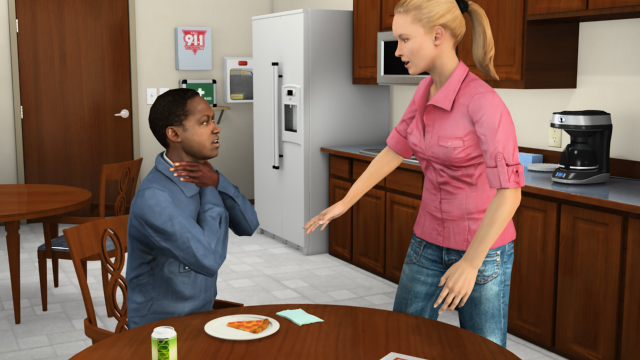




First Aid – Breathing Emergencies
People can have difficulty breathing for many reasons; these can be universally referred to as breathing emergencies. Breathing emergencies can be caused by choking, a punctured lung, an allergic reaction, exposure to chemicals or other toxins, asthma, and other causes. In this course you’ll learn more about the causes of breathing emergencies, symptoms of breathing emergencies, how to provide first aid, and you’ll get guidance on calling for emergency medical assistance.
Request a demoCourse Details
Learning Objectives
By the end of this course, you will be able to:
- List some causes and symptoms of breathing emergencies
- Describe some initial first aid for a breathing emergency
- Explain what abdominal thrusts are and how and when to perform them
- Recall how and when to provide artificial respiration
- Explain when to provide cardiopulmonary resuscitation (CPR)
Specs
| Course Level | Intermediate |
| Languages | English |
| Compatibility | Audio, Video |
| Based on: | Industry Standards and Best Practices |
Key Questions
What are breathing emergencies?
“Breathing emergencies” is a general term used to refer to different cases in which a person might be having difficulty breathing or can’t breathe.
What are some causes of breathing emergencies?
Breathing emergencies can have a large number of different causes. These can include allergies, exposures to chemicals or toxins, choking, punctured lungs, and other causes.
What is the first thing to do if someone is having trouble breathing?
Check to see if their airway is clear and, if possible, clear it.
Is it OK to use the Heimlich maneuver if someone is choking?
Yes, but only in serious cases, because performing the Heimlich maneuver can cause serious injuries to the person. If the person can still talk, don’t perform the Heimlich maneuver. Only use the Heimlich maneuver as a last resort.
What other first aid procedures might a person have to perform for a person who is having difficulties breathing?
It’s possible you might have to perform artificial respiration or CPR.
Sample Video Transcript
If a person is choking on an object lodged in the throat, in many cases he or she will cough hard enough to dislodge the object. In some cases, however, the victim can’t dislodge the object and needs first aid. This is done by using the Heimlich maneuver. However, performing the Heimlich maneuver can seriously injure the person. It can cause significant bruises, break ribs, or damage internal organs. Therefore, you should use the Heimlich maneuver only when the victim can’t dislodge a foreign object by coughing and when the victim’s breathing is completely or nearly completely blocked. If a person can talk or yell, don’t use the Heimlich maneuver.
Additional Resources
- US National Library of Medicine (NLM) – www.nlm.nih.gov
- NLM Medline Plus – https://www.nlm.nih.gov/medlineplus/ency/article/000007.htm
- WebMD – www.webmd.com
- WebMD Breathing Problems webpage: http://www.webmd.com/lung/breathing-problems-causes-tests-treatments
- WebMD First Aid – http://www.webmd.com/lung/lung-injuries
- WebMD First Aid – http://www.webmd.com/first-aid/asthma-treatment
- WebMD Choking First Aid webpage: http://www.webmd.com/first-aid/choking-treatment
- Mayo Clinic – www.mayoclinic.org
- Mayo Clinic First Aid – http://www.mayoclinic.org/first-aid/first-aid-choking/basics/art-20056637
- eMedicineHealth – www.emedicinehealth.com
- eMedicineHealth First Aid – http://www.emedicinehealth.com/choking/page8_em.htm
Course Applies To
Demos + Pricing
Learn more about our courses, get pricing, and see our platform.











